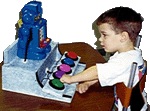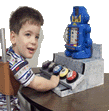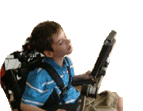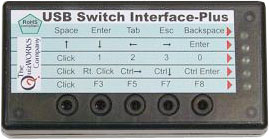|
PC-PEK230
|
Occumatics
Overview - Occumatics
Product Type: Worksheets
Author: Scott Robert Poor
Number of Pages: 216 pages
Reproducible: Yes
Reading Level: Secondary, Adult
Age Appropriate Level: Yes
Copyright: 1991This innovative program
introduces students to 36 occupations while featuring
practical, everyday uses of math in "real-life" situations.
It was developed as a method of showing students the
complete cycle of math, from basic fact-learning to applied
math skills in the workplace. The assignments cover many
different math-related situations that students will
encounter as adults. The inventive mix of occupations and
mathematics is what makes Occumatics a unique and valuable
program.
Components
Occumatics is presented in a sturdy three-ring binder
divided into tabbed sections entitled Occumatics I (covering
whole numbers and decimals and designed to be completed in
one semester) and Occumatics II (covering whole numbers,
decimals, and fractions in the second semester). Each
section is outlined in 18, one-week units so that the
lessons can be easily integrated into any school curriculum.
Each unit consists of Job Chat, Skill Check, Applied Skill,
and Puzzle Time. Teaching suggestions and Answer Key are
included in the binder.
Job Chat.
These are math story problems that relate to a specific
occupation. They can be completed either as a group or
individual activity. To enhance this portion, guest speakers
from the specific occupations could be invited to visit the
class.
Skill Check.
These are to be completed individually. Depending on each
student's skill they can complete the problems by longhand
or calculator. The Think Box portion of the skill check is
designed to make students look at the basic math operations
from a higher level of thinking.
Applied Skill.
This can be completed either individually or as a group.
Students should use calculators in order to gain
proficiency, as the use of calculators is realistic in these
work situations.
Puzzle Time.
This can be completed individually or in small groups. It is
designed to be fun. Although it might seem that the puzzles
are repeating what the Skill Check page has done, it is
important to provide the constant, consistent practice
needed by students to build and sharpen their abilities.
When presented with ongoing review throughout the school
year, students can improve their levels of proficiency with
the four basic operations involving whole numbers and
decimals. The program teaches students how to determine
weekly pay rate, give and receive change, understand and
calculate sales price, budget while shopping, understand
simple banking terms, and solve many other day-to-day math
situations. The binder contains 216 reproducible Student
Worksheets that cover addition, subtraction, multiplication,
division, fractions, decimals, percents, and metrics.
Objectives
-Become more proficient with the basic four math
operations in the areas of whole numbers, decimals, and
fractions.
-Become more proficient in practical life skills that relate
to math.
-Be able to answer math story problems that relate to a
specific occupation.
-Be able to list ways that math would be used in different
occupations.
-Be able to write answers that demonstrate an understanding
of the general procedures involved in specific occupations.
-Be able to answer questions of a conceptual nature
concerning different occupations.
-Complete puzzles by answering math questions.
The occupations used to illustrate the math activities
include kitchen worker, vending machine mechanic, architect,
teacher, telephone repairman, computer programmer, railroad
conductor, bank teller, pilot, nurse, librarian, newspaper
reporter, plumber, forester, automobile salesperson, police,
stone mason, meat cutter, auto mechanic, model, taxi driver,
social worker, beautician, telephone operator, mail carrier,
firefighters, photographer, air traffic controller, disc
jockey, truck driver, accountant, heavy equipment operator,
locksmith, meteorologist, jeweler, and insurance
salesperson.
Applied skills include time card hours, overtime pay,
making change, sales tax, figuring profit, deposit slip,
savings account, check writing, check register, paycheck
deductions, figuring the bill, gas mileage, sale price
savings, story problems, weights and measures, averages,
writing numbers in words, chain math problems, map reading,
budgeting, perimeter and area, phone bills, money problems
itemized bills, shopping, and first apartment.
|

|
|





